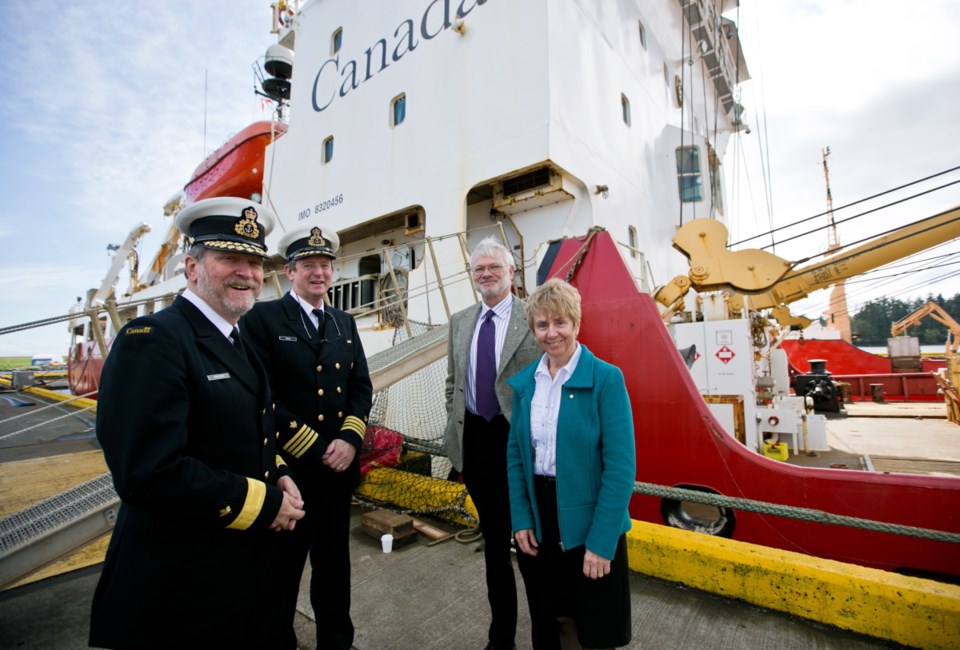 To Sen. Nancy Greene Raine, finding the lost ship of the Franklin Expedition was politically significant, a key to Canadian identity and sovereignty.
To Sen. Nancy Greene Raine, finding the lost ship of the Franklin Expedition was politically significant, a key to Canadian identity and sovereignty.
To Joseph Frey of the Royal Canadian Geographical Society, the discovery of HMS Erebus was of historical importance. “If it weren’t for Franklin’s loss, the Arctic archipelago might not have become Canadian.”
To the Canadian Coast Guard’s Roger Girouard, it was that and more: a mystery, a sea story, a tale of national pride (just like skier Nancy Greene’s Olympic gold in 1968, he noted).
And, in a world with so few corners left to explore, it was about pulling a thread that could be traced back through Cook, Columbus and da Gama. Oh, the romance of it all.
Just back from three weeks off the west coast of Vancouver Island — an adventure in itself to most of us — 22 crew members of the coast guard ship Sir Wilfrid Laurier piled into the auditorium of Sidney’s Institute of Ocean Sciences, where they received medals from the aforementioned trio Monday.
The Victoria-based vessel played a central role in last September’s discovery of the Erebus, intact on the Arctic Ocean floor, more than 160 years after it disappeared.
The Erebus’s fate, along with that of sister ship HMS Terror, has long been one of the world’s great mysteries. Led by explorer Sir John Franklin, the Arctic expedition left England in May 1845 with 129 men aboard the two vessels. The ships were spotted entering Baffin Bay that August — then simply vanished.
The ever-forceful Lady Jane Franklin drove a series of searches that failed to find her husband’s vessels (she actually spent a month in Victoria in 1861) but that gradually filled in the map of the north, cementing Britain’s — and subsequently Canada’s — territorial claims.
Eventually, the fate of the Franklin men emerged: After becoming stuck in the ice of Victoria Strait in 1846, they finally abandoned the ships in April 1848. They set out overland in a desperate bid to reach Fort Resolution, 1,000 kilometres away, but none survived. Indications are some resorted to cannibalism.
For the past seven summers, the Laurier has set out for the Arctic, the Franklin hunt being part of its agenda. “Where we went is uncharted,” notes Capt. Bill Noon. “We had to make our own chart just to get into the area in 2008.”
Last September, the search finally paid off, with the Erebus being found upright in 11 metres of water, intact.
The news rocketed around the globe. New Yorker magazine put it thusly: “To translate it from Canadian into American terms, it is as if someone had found, in a single moment, the hull of the Titanic, the solution to the mystery of the lost colony at Roanoke, the original flag of The Star-Spangled Banner, and the menu for the Donner Party’s last meal.”
It has been particularly big news in Britain and Australia. Noon just returned from an official trip Down Under, where he was not only hosted by the mucky-mucks but earned a terrific welcome in a pub in Franklin, pop. 3,800, when they learned his reason for visiting.
Noon is among those (Greene Raine’s sister is another) who has long been intrigued by the Franklin puzzle. His cabin on the Laurier contains maybe 20 books on the subject, everything from The Man Who Ate His Boots to Unravelling The Franklin Mystery: Inuit Testimony, written by David Woodman, a B.C. Ferries captain, ex of Victoria. Noon makes no secret about being thrilled by the Laurier’s role — and by exploring the last corners of the unknown.
Others share the feeling. “The ocean’s like the final frontier,” said Laurier crew member Dave Steel after Monday’s ceremony. Last summer’s voyage was Steel’s first to the Arctic, where he was mesmerized by what happens when, on a sunny day, the Arctic’s barren landscape, open water and sky converge. “The skyline and horizon tend to disappear. It looks like you’re floating in the sky. It’s the epicentre of tranquility.”
Imagine that while trapped in your office cubicle.
The Erebus has been untouched since its bell was raised last fall. Parks Canada and the Royal Canadian Navy will set up a dive camp in April — it being easier to dive through the ice than from a storm-tossed ship — and then the underwater archeologists will get a chance to poke. “The discovery brings us a step closer to finding out what actually did happen to the Franklin Expedition,” Frey says. “Hopefully there will be clues on the ship about the final months and weeks and days.”
As for the Laurier, it will leave Victoria on July 4, heading for Victoria Strait and two weeks of intense searching for the other missing ship, HMS Terror.
Franklin Fever has set in, Noon says. “The carrot’s there. We know what it tastes like.”



